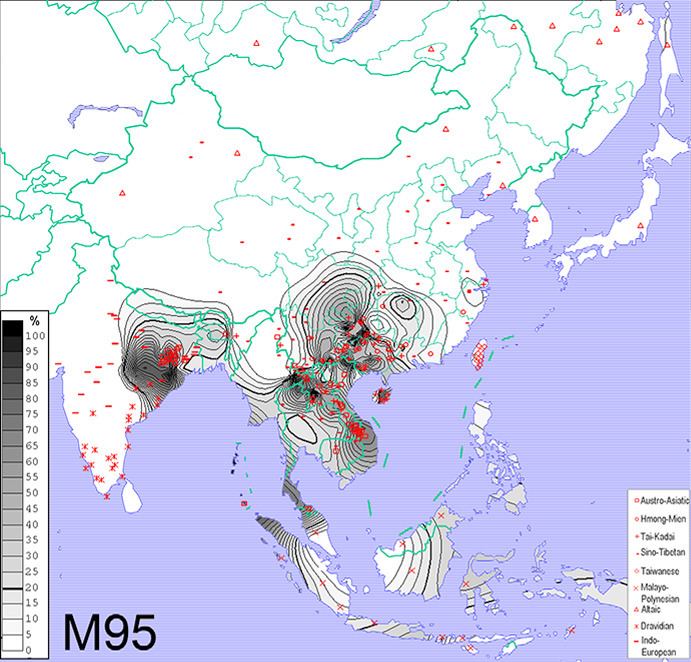Ancestor O-P31 | Descendants O-CTS10887, O-PK4 | |
 | ||
Possible time of origin about 22,200 [95% CI 20,000 <-> 24,400] years before present (most recent common ancestor of O-CTS10887 and O-PK4) Defining mutations K18, F1888/M1356, M1307/K19, M1446, plus 63 other SNPs | ||
In genetics, Haplogroup O-K18 is a human Y-chromosome DNA haplogroup. Haplogroup O-K18 is a descendant branch of Haplogroup O-P31. It is best known for the high frequency of its O-M95 subclade among populations of Southeast Asia and among speakers of Austroasiatic languages in South Asia.
Contents
Distribution
Haplogroup O-K18 is distributed widely in Asia, from southern India to the Altai Mountains and Central Asia in the west, and from Indonesia to northern China and Japan in the east. It is found only at marginally low frequencies of approximately 1% at the periphery of its distribution in southern India, Central Asia, northern China, and Japan, but many populations within the vast intervening territory in South Asia, Southeast Asia, and southern China display a greatly elevated frequency of Haplogroup O-K18 Y-chromosomes. Patrilines within the O-M95 subclade of Haplogroup O-K18 predominate among the Austroasiatic-speaking populations of South and Southeast Asia, such as the Khmer of Cambodia and the Khasi of Meghalaya in northeastern India. Some researchers have reported that slightly over half of all men in a composite sample of Austroasiatic speakers belonged to Haplogroup O-M95. Haplogroup O-M122, which attains its peak frequency among the Sino-Tibetan and Hmong–Mien peoples of China and Southeast Asia, and Haplogroup O-M119, which predominates among Taiwanese aborigines and many populations of the Philippines, also generally occur among speakers of Austroasiatic languages in South China and the Indochinese Peninsula, but usually at much lower frequencies than Haplogroup O-M95. The hypothesis that Haplogroup O-M95 was the major Y-chromosome haplogroup of the proto-Austroasiatic population is strengthened by the fact that Haplogroup O-M95 is the only haplogroup found among many Austroasiatic-speaking tribes, such as the Mlabri people of Thailand, Mang people of southern China and northern Vietnam, Juang of mainland India, and the Nicobarese and Shompen of the Nicobar Islands (Sahoo 2006 and Trivedi 2006).
Haplogroup O-M95 also has been observed with high frequency in samples of Tai–Kadai-speaking peoples of Thailand and neighboring areas, which may reflect assimilation of the older Austroasiatic Mon–Khmer populations that have left ample evidence of their presence in the region prior to the immigration of Tai–Kadai speakers.
Outside of the region in which Austroasiatic languages are currently spoken or have a historically attested presence, Haplogroup O-M95 reaches its highest frequencies among the populations of the islands of Sumatra, Java, Bali, and Borneo in western and central Indonesia (Underhill 2001). Haplogroup O-M95 has been found to be by far the most common Y-chromosome haplogroup among the Balinese, occurring in approximately 58.6% (323/551) of a sample of Balinese men; Haplogroup O-M119 and Haplogroup O-M122, which are typical of Austronesian peoples outside of Malaysia and Indonesia, were observed in only 18.1% (100/551) and 6.9% (38/551) of Balinese men (Karafet 2005). Haplogroup O-M95 has also been found to be the most frequently occurring haplogroup among Malay men in Singapore (Yong 2006). The reason for its substantial presence in these populations, all of which are Austronesian-speaking, is yet to be elucidated.
Subclade distribution
Phylogenetic history
Prior to 2002, there were in academic literature at least seven naming systems for the Y-Chromosome Phylogenetic tree. This led to considerable confusion. In 2002, the major research groups came together and formed the Y-Chromosome Consortium (YCC). They published a joint paper that created a single new tree that all agreed to use. Later, a group of citizen scientists with an interest in population genetics and genetic genealogy formed a working group to create an amateur tree aiming at being above all timely. The table below brings together all of these works at the point of the landmark 2002 YCC Tree. This allows a researcher reviewing older published literature to quickly move between nomenclatures.
Research publications
The following research teams per their publications were represented in the creation of the YCC Tree.
Phylogenetic trees
This phylogenetic tree of haplogroup O subclades is based on the YCC 2008 tree (Karafet 2008) and subsequent published research.
